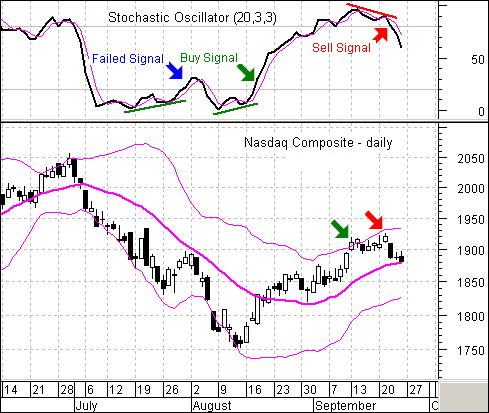
HOT TOPICS LIST
- MACD
- Fibonacci
- RSI
- Gann
- ADXR
- Stochastics
- Volume
- Triangles
- Futures
- Cycles
- Volatility
- ZIGZAG
- MESA
- Retracement
- Aroon
INDICATORS LIST
LIST OF TOPICS
PRINT THIS ARTICLE
by Arthur Hill
The Nasdaq advance since mid-August is beginning to stall out and the index is on the verge of a Bollinger Band sell signal.
Position: Sell
Arthur Hill
Arthur Hill is currently editor of TDTrader.com, a website specializing in trading strategies, sector/industry specific breadth stats and overall technical analysis. He passed the Society of Technical Analysts (STA London) diploma exam with distinction is a Certified Financial Technician (CFTe). Prior to TD Trader, he was the Chief Technical Analyst for Stockcharts.com and the main contributor to the ChartSchool.
PRINT THIS ARTICLE
BOLLINGER BANDS
Bollinger Band Signal Brewing On The Nasdaq
09/27/04 01:52:21 PMby Arthur Hill
The Nasdaq advance since mid-August is beginning to stall out and the index is on the verge of a Bollinger Band sell signal.
Position: Sell
| A Bollinger Band sell signal occurs when prices reach the upper Bollinger Band, pull back, move higher, and then fail to touch the upper Bollinger Band. Because these bands are based on closing prices, traders should also use closing prices when looking for signals (as opposed to intraday highs and lows). A subsequent close below the 20-period simple moving average (SMA) (middle Bollinger Band) confirms the signal with the lower band as the first target. |
| Taking a look at the Nasdaq, we can see a Bollinger Band sell signal over the last two weeks. The index closed above the upper band on September 13 (1910.38) and September 14 (1917.74). There was a small pullback, and the index then moved to a new closing high on September 21 (1921.18). Despite the higher close, the index closed below the upper band (red arrow). The decline below 1900 carried the index back to the 20-day SMA, and further weakness with a close below this level would confirm the sell signal. |

|
| Figure 1: Stochastic oscillator, Nasdaq Composite |
| Graphic provided by: MetaStock. |
| |
| In addition to the Bollinger Band sell signal, the stochastic oscillator confirms with a sell signal of its own. For the stochastic oscillator, a bearish divergence followed by a move below 80 constitutes a sell signal. Conversely, a bullish divergence followed by a move above 20 constitutes a buy signal. There were buy signals in late July (bad signal) and mid-August (good signal). In addition, there was a sell signal in mid-September (red arrow). This confirms the Bollinger Band sell signal and makes it more robust. A move back above 1900 in the index would be enough to negate these recent sell signals. |
Arthur Hill is currently editor of TDTrader.com, a website specializing in trading strategies, sector/industry specific breadth stats and overall technical analysis. He passed the Society of Technical Analysts (STA London) diploma exam with distinction is a Certified Financial Technician (CFTe). Prior to TD Trader, he was the Chief Technical Analyst for Stockcharts.com and the main contributor to the ChartSchool.
| Title: | Editor |
| Company: | TDTrader.com |
| Address: | Willem Geetsstraat 17 |
| Mechelen, B2800 | |
| Phone # for sales: | 3215345465 |
| Website: | www.tdtrader.com |
| E-mail address: | arthurh@tdtrader.com |
Traders' Resource Links | |
| TDTrader.com has not added any product or service information to TRADERS' RESOURCE. | |
Click here for more information about our publications!
Comments
Date: 09/28/04Rank: 5Comment:
Date: 05/04/17Rank: 3Comment:

|

Request Information From Our Sponsors
- StockCharts.com, Inc.
- Candle Patterns
- Candlestick Charting Explained
- Intermarket Technical Analysis
- John Murphy on Chart Analysis
- John Murphy's Chart Pattern Recognition
- John Murphy's Market Message
- MurphyExplainsMarketAnalysis-Intermarket Analysis
- MurphyExplainsMarketAnalysis-Visual Analysis
- StockCharts.com
- Technical Analysis of the Financial Markets
- The Visual Investor
- VectorVest, Inc.
- Executive Premier Workshop
- One-Day Options Course
- OptionsPro
- Retirement Income Workshop
- Sure-Fire Trading Systems (VectorVest, Inc.)
- Trading as a Business Workshop
- VectorVest 7 EOD
- VectorVest 7 RealTime/IntraDay
- VectorVest AutoTester
- VectorVest Educational Services
- VectorVest OnLine
- VectorVest Options Analyzer
- VectorVest ProGraphics v6.0
- VectorVest ProTrader 7
- VectorVest RealTime Derby Tool
- VectorVest Simulator
- VectorVest Variator
- VectorVest Watchdog
